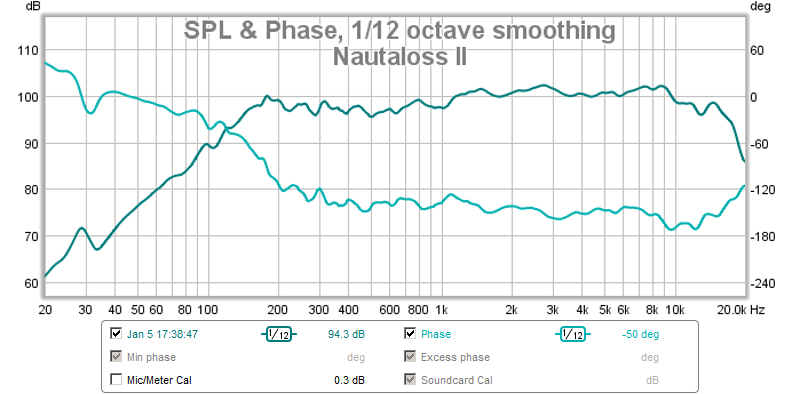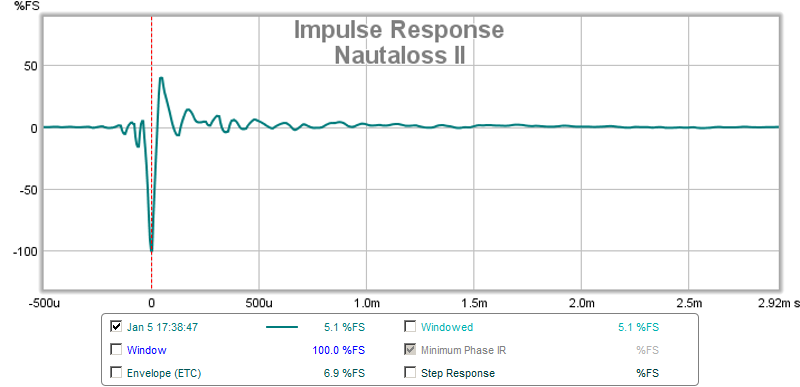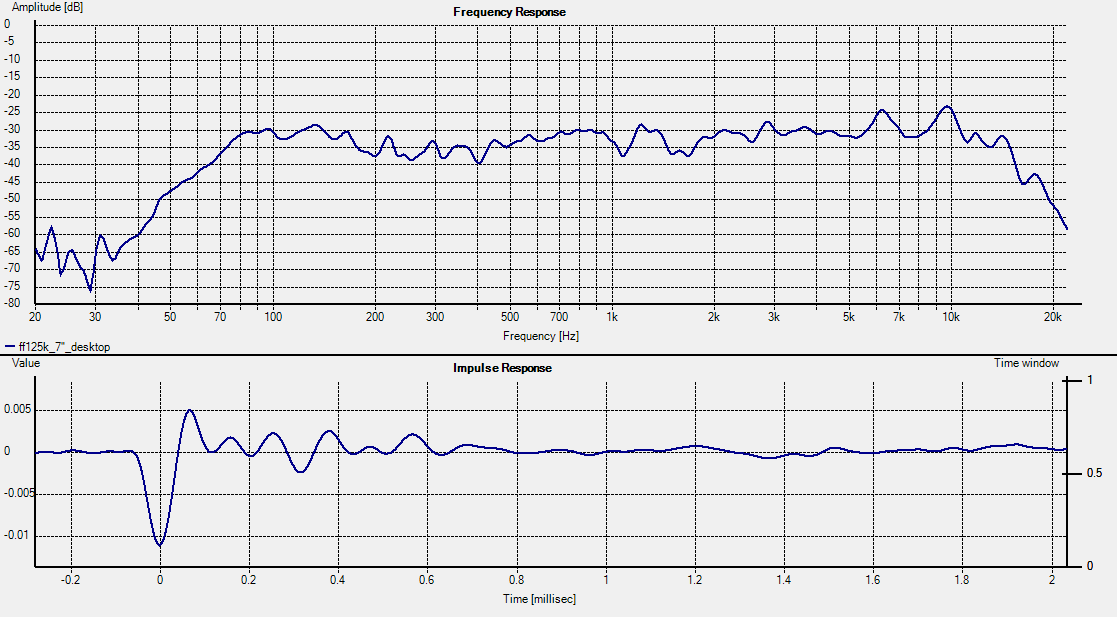It would be interesting to realize the internal shape in plywood as for drum shells:
www.sonormuseum.com/1987/features/sigshell.jpg
Inviato dal mio Droid DNA utilizzando Tapatalk
www.sonormuseum.com/1987/features/sigshell.jpg
Inviato dal mio Droid DNA utilizzando Tapatalk
How does one make a drum shell ? Heat and steam plywood or is it made using many layers of curved ply that are then bonded and clamped together a curve? I think use foam core internally and wood on outside. That makes it way to bend and the foam core also provides some damping. I think the ultimate Nautaloss would be a long 3 ft tapered glass flask that a glass blower heats and coils into a spiral. The mouth could then be fitted with either a nice wooden baffle or a clear plexiglass baffle could be fitted. The clear glass would only look cool with no stuffing in the line.
Can somebody explain me how they can read woofer decay speed.. from just FR or Impulse ... i wish people would publish waterfall CSD plots..
My guess is that FR bumps are waterfall csd resonnances spots..
still.. I'm looking for the fasted decay small driver... anybody have any idea how fast the decay is of those tested here..
My guess is that FR bumps are waterfall csd resonnances spots..
still.. I'm looking for the fasted decay small driver... anybody have any idea how fast the decay is of those tested here..
The frequency response is a graph of the power distribution vs frequency space. Frequency space and time domain are related by the Fourier transform. The raw data from most frequency response curves is obtained by sweeping the frequency generator of the source signal and measuring system response. The software then does an inverse Fourier transform of the response (actually implemented with what is known as the Fast Fourier Transform (FFT) - an algorithm to do the Fourier transform on a discrete set of data points quickly in computer code). This produces the impulse response (IR) or response of the system as a function of time. Note that the IR contains all the information to derive the frequency response and in fact, a better (but more difficult) way to get the FR is to have a setup that produces impulse step functions and a high speed microphone to measure the temporal pulse, then take the FFT of the time response to get the frequency response.
I did show spectrogram (like a 2d waterfall contour plot) plot of the Nautaloss early on - although I may not have set the time gating properly. Look at this post: http://www.diyaudio.com/forums/full-range/247598-nautaloss-ref-monitor-11.html#post3766222
The FR of the Nautaloss II is here:

The corresponding IR is this:

Here, the phase appears to be backwards either on the mic or the amp/speaker. But look at how quickly the driver hits a peak and returns to zero (with overshoot). The main impulse peak and return occurs in about 100 microseconds (or 10 kHz equivalent frequency). So that is the IR derived impulse response of the TC9FD in a Nautaloss II enclosure. It is dominated by the flatness of the FR curve and the smoothness of the tails of the curve. Every little ripple and dip in the IR is a corresponding frequency peak or dip in the FR.
A sloppy or bumpy FR cannot produce a sharp IR with minimal ringing. The ugglier the FR, the more rippled the IR will be and vice versa.
I hope that helps.
The question of the "fastest" decay driver will probably point to a smaller dome tweeter that can reach 25 kHz. And maybe ribbon tweeters that reach 30 kHz. For tweeters that have capability beyond the range of human hearing is not a waste in that it means those drivers are inherently capable of reproducing fast transients better.
Hope that helps.
I did show spectrogram (like a 2d waterfall contour plot) plot of the Nautaloss early on - although I may not have set the time gating properly. Look at this post: http://www.diyaudio.com/forums/full-range/247598-nautaloss-ref-monitor-11.html#post3766222
The FR of the Nautaloss II is here:

The corresponding IR is this:

Here, the phase appears to be backwards either on the mic or the amp/speaker. But look at how quickly the driver hits a peak and returns to zero (with overshoot). The main impulse peak and return occurs in about 100 microseconds (or 10 kHz equivalent frequency). So that is the IR derived impulse response of the TC9FD in a Nautaloss II enclosure. It is dominated by the flatness of the FR curve and the smoothness of the tails of the curve. Every little ripple and dip in the IR is a corresponding frequency peak or dip in the FR.
A sloppy or bumpy FR cannot produce a sharp IR with minimal ringing. The ugglier the FR, the more rippled the IR will be and vice versa.
I hope that helps.
The question of the "fastest" decay driver will probably point to a smaller dome tweeter that can reach 25 kHz. And maybe ribbon tweeters that reach 30 kHz. For tweeters that have capability beyond the range of human hearing is not a waste in that it means those drivers are inherently capable of reproducing fast transients better.
Hope that helps.
I hope that helps.
The question of the "fastest" decay driver will probably point to a smaller dome tweeter that can reach 25 kHz. And maybe ribbon tweeters that reach 30 kHz. For tweeters that have capability beyond the range of human hearing is not a waste in that it means those drivers are inherently capable of reproducing fast transients better.
Hope that helps.
yep that help's a lot thx for taking your time to explain that to me..
for the "fastest" decay driver i was more talking about the 2" to 5" ones.. or even the 5,6,7,8" ... because i'm used to electrostatics mids fast transient, fast decay and vanishing low distortion.. =) i think a saw a CSD plot of the Vifa and it wasnt near that decay you have on your build.. what is the crossover points used for the vifa..
Last edited:
actually when i look at the ripple in your impulse it still kinda too slow decay for me. I want full stop in the 500u or 1.0m..
distortion and extension is really really good on that low cost vifa tho... the tc7 ferrite seem to have even less distortion, better dispersion and might have faster decay.. but low end extensions make them nearly impossible to cross at 80-100hz.. I wonder if a wall of sound, or array and higher crossover point could help that impulse since it would mean each driver would have to move less air..
distortion and extension is really really good on that low cost vifa tho... the tc7 ferrite seem to have even less distortion, better dispersion and might have faster decay.. but low end extensions make them nearly impossible to cross at 80-100hz.. I wonder if a wall of sound, or array and higher crossover point could help that impulse since it would mean each driver would have to move less air..
Last edited:
More drivers just give higher SPL but transient response will be the same. The allure of the 25 driver TC9FD line array is that it has the transient response of a 3.5 in driver but the ability to move air like a 18 in woofer in cone surface area. So you get forceful bass and snappy transients. It will tough to find a speaker with a cleaner IR than what the Nautaloss shows - those ripples are quite minor compared to the initial pulse. IIRC, the data shown was for the driver running full range so no XO. It is best used with a high pass (at least 24 dB/oct) at about 150 to 200 Hz. That relieves the driver from large excursions and you can actually put a lot of power into it for higher SPL's without hitting xmax and reduce inter modulation distortion.
Last edited:
look at the new celestion an2075 small array drivers CSD plot measured in voice coil..
while distortion isnt as good as the vifa.. the decay is really really fast..
Sad they they didnt measure the AN2775 but if we look at the FR of the An2775 it seems flatter... so i guess might mean even better decay.. also i wonder what that high 1.5 qts will have for effect on a small driver like this.. does this mean the magnet |motor isnt really strong for a 2.75 inch woofer...
I guess open baffle with the An2775 would be a nice experiment.. also that intense drop in the low might be very useful for the low crossover point.. (wonder how i would implement that high pass filter tho and what subwoofer i would select to match)
still the woofer is made of aluminium instead of paper like the vifa.. so i wonder how the voicing will be... maybe the vifa will be less harsh and more warm for PA duties... very important since at high spl.. harshness is kinda a buzz kill
in any case im thinking i might still use a ribbon in the array for 8hz and up... (if i take the 2.75") if i take the 2" than comb filtering is in the 10khz range and not sure will be an issue..
but well maybe my only chance for really fast decay is with the B&G Neo10 mid
let me know of your expert opinion =)
while distortion isnt as good as the vifa.. the decay is really really fast..
Sad they they didnt measure the AN2775 but if we look at the FR of the An2775 it seems flatter... so i guess might mean even better decay.. also i wonder what that high 1.5 qts will have for effect on a small driver like this.. does this mean the magnet |motor isnt really strong for a 2.75 inch woofer...
I guess open baffle with the An2775 would be a nice experiment.. also that intense drop in the low might be very useful for the low crossover point.. (wonder how i would implement that high pass filter tho and what subwoofer i would select to match)
still the woofer is made of aluminium instead of paper like the vifa.. so i wonder how the voicing will be... maybe the vifa will be less harsh and more warm for PA duties... very important since at high spl.. harshness is kinda a buzz kill
in any case im thinking i might still use a ribbon in the array for 8hz and up... (if i take the 2.75") if i take the 2" than comb filtering is in the 10khz range and not sure will be an issue..
but well maybe my only chance for really fast decay is with the B&G Neo10 mid
let me know of your expert opinion =)
Last edited:
IG,
What kind of enclosure is that in? Very good performance and I have always like the AE 15TDM driver. There are some ringing peaks though. The single peak rise and fall time indicates it can go up to about 5khz which is pretty good for a 15 in driver.
These larger fella's in the back. There are FR drivers in the pic so as not to be too OT...
An externally hosted image should be here but it was not working when we last tested it.
5cu.f vented to ~32Hz. They do hit ~5kHz on-axis and I ran them fullrange in these enclosuresvwith the back removed once (U-frame essentially) and it sounded surprisingly more "fullrange" than I expected on both ends of the spectrum. Bringing-in a helper tweeter first or second order around 5-6kHz could sound pretty decent despite obvious technical flaws. TD15M can work in sealed enclosures too, if not so much extension is desired. Someone willing to build a large-*** nautilus conch for these may have something pretty good going on.
Yeah, some ringing, still is a ~13" effective diameter cone if I understand that well. The bass alignment is very well-damped OTOH, low-Q, broad, output around 8db down relative to cone. f3~60Hz, f10~32Hz IIRC. I think it looks fairly settled around 1ms, but the reflection and gating time is lousy in my room, so who know if there'd be small warts that are covered up above.
Last edited:
Since we're talking IR, here's the little FF125K's pictured on stands in my previous post. Enclsosures are ~8L/69Hz. Calibrated UMM-6, ~7" away, speaker in its desktop position:

FWIW, there is ~2-3ohm of drive impedance from the SE 6GW8 amp.
In any case, when can we call the impulse response settled? <10% of the initial peak value? Less?
FWIW, there is ~2-3ohm of drive impedance from the SE 6GW8 amp.
In any case, when can we call the impulse response settled? <10% of the initial peak value? Less?
Attachments
Last edited:
IG,
That is a very nice setup you have there. The FF125wk response in a bass reflex looks very good too. Interesting wide baffle with offset driver and bass port positions. I am sure your listening room sounds awesome
X
Box is acoustic ratio (0.8:1:1.25) and the driver offset is golden ratio, both horizontal and vertical. The vent is simply underneath for the looks.
Funny see here picture-1 FF125WK verse Vifa set up in "WinspeakerZ" sealed Qtc 0,78, though in SPL mode FF125WK is approximately +3dB. IG81 thanks for sharing inspiration and data, very fine mans corner you have there in living room "HIFI/fishing gear"  .
.
Could imagine some DSP bring FF125WK and TD15M in same phase domain would make a great FAST. Picture-2 FF125WK/TD15M sealed Qtc 0,707 though in SPL mode bass is +8,8dB.
(Edit changed picture-2 to the right one)
Could imagine some DSP bring FF125WK and TD15M in same phase domain would make a great FAST. Picture-2 FF125WK/TD15M sealed Qtc 0,707 though in SPL mode bass is +8,8dB.
(Edit changed picture-2 to the right one)
Attachments
Last edited:
Funny see here picture-1 FF125WK verse Vifa set up in "WinspeakerZ" sealed Qtc 0,78, though in SPL mode FF125WK is approximately 3dB better. IG81 thanks for sharing inspiration and data, very fine mans corner you have there in living room "HIFI/fishing gear".
Could imagine some DSP bring FF125WK and TD15M in same phase domain would make a great FAST. Picture-2 FF125WK/TD15M sealed Qtc 0,707 though in SPL mode bass is +8,8dB.
(Edit changed picture-2 to the right one)
Just to note, my driver is the old FF125K, no "W".
FF125K would make a great mid/tweeter over a proper woofer. TD15M's bandwidth would be "wasted" in a way, but lots of clean overlap is good for Xo design.
Sorry mistake/ignorance by meJust to note, my driver is the old FF125K, no "W"......
 .
.Sorry mistake/ignorance by me.
No prob. Hey, I didn't even catch it, but xrk971 also wrote "WK"...
Hi IG81, is the AE box a variation on the "Cornscala"?
Well no, but after having built it, someone rightly pointed out the similarity to me; I'm not particularly familiar with most things Klipsch. As much a variation on a CornScala as any box with a 2" round port is a variation on 95% of reflex boxes ever built.
metallic spiral
i'm interesting for building something like this cheap loudspeaker.
I want to have some recommendations about this.
making this metallic is the easy way for me,but i want opinions about this.
Thimios.
i'm interesting for building something like this cheap loudspeaker.
I want to have some recommendations about this.
making this metallic is the easy way for me,but i want opinions about this.
Thimios.
Attachments
Last edited:
- Home
- Loudspeakers
- Full Range
- The Nautaloss Ref Monitor





